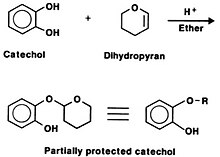Charles J. Pedersen
Charles John Pedersen 安井 良男 | |
|---|---|
crown ethers Development of metal deactivators | |
| Awards | Nobel Prize in Chemistry (1987) |
| Scientific career | |
| Fields | Organic chemistry |
| Institutions | DuPont |

Charles John Pedersen (Japanese: 安井 良男, Yasui Yoshio, October 3, 1904 – October 26, 1989) was an American organic chemist best known for discovering crown ethers and describing methods of synthesizing them during his entire 42-year career as a chemist for DuPont at DuPont Experimental Station in Wilmington, Delaware, and at DuPont's Jackson Laboratory in Deepwater, New Jersey.[1] Often associated with Reed McNeil Izatt, Pedersen also shared the Nobel Prize in Chemistry in 1987 with Donald J. Cram and Jean-Marie Lehn. He is the only Nobel Prize laureate born in Korea other than Peace Prize laureate Kim Dae-jung.[2]
Pedersen made countless other discoveries in chemistry, such as discovering and developing metal deactivators.[3] His early investigations also led to the development of a dramatically improved process for manufacturing tetraethyl lead, an important gasoline additive.[4] He also contributed to the development of neoprene.[5]
Early life and education
Born on October 3, 1904, in
Despite living in what is now South Korea, because Pedersen lived in the vicinity of the American-owned Unsan County mines, which spanned approximately 500 square miles in area,[11] he grew up speaking primarily English.[7]
At around 8 years old, Pedersen was sent by his family to study abroad in Nagasaki, Japan and then later transferred to St. Joseph College in Yokohama, Japan.[12]
After successfully completing his education at St. Joseph College,
While spending his undergraduate life in 1922 studying chemical engineering at the University of Dayton in Ohio, Pedersen had been a well balanced student who immersed himself in the sports, academic and social aspects of his college. With a passion for the sport of tennis, Pedersen played on his school's varsity tennis team under Coach Frank Kronauge, a former University of Dayton tennis captain.[13] Playing for all four years of his undergraduate years, Pedersen became captain for both of his junior and senior seasons on the team.[13] Furthermore, Pedersen spent his time as both the vice-president of the Engineers' Club as well as in charge of Literary in the Daytonian Editorial Department[13]. Graduating from the University of Dayton in 1926 with a degree in chemical engineering,[13] he was dedicated for his time at the university as well as the various accomplishments he made while studying as an undergraduate.
Earning a
Du Pont
After leaving the
Retiring at the age of 65, his work resulted in 25 papers and 65 patents, and in 1967, he published two works describing the methods of synthesizing
Discovery of the crown ethers
At around 1960, Pedersen went back to research in the field of

Due to not being
Associations with other chemists
Reed M. Izatt
In 1968
Donald J. Cram
Cram shared the 1987 Nobel Prize in Chemistry with Pedersen but expanding on Pedersen's monumental discovery in macrocyclic chemistry of crown ethers.[8] Pedersen's work was in two-dimensional structures but Cram was able to synthesize similar molecules in three-dimensional space. Cram's synthesis of these three-dimensional molecules provided large gains in the production of enzymes made in labs as these structures have selectivity based on complementary structures.[21]
Jean-Marie Lehn
Lehn was the other scientist who shared the Nobel Prize in Chemistry with Pedersen and was fundamental in starting the field of Supramolecular chemistry. Lehn's work specifically identified in his recognition for the Nobel Prize was in his work on cryptands.[14]
Miscellaneous research
Although minimal research has been conducted on this
Personal life
Pedersen was married to Susan J. Ault in 1947
Legacy
Following Pedersen's breakthrough in realizing his accidental product and structure of
Publications
- Pedersen, Charles J (1988). "The Discovery of Crown Ethers". Science. 241 (4865): 536–540. PMID 17774576.
- Pedersen, Charles J (1967). "Cyclic polyethers and their complexes with metal salts". Journal of the American Chemical Society. 89 (10): 2495–2496. .
See also
- List of Japanese Nobel laureates
References
- ^ "The Nobel Prize in Chemistry 1987". NobelPrize.org. Retrieved 2023-11-06.
- ^ "DJ와 또 한 명 … 노벨위원회엔 '한국 출생 수상자' 2명 기록 [DJ and another ... Nobel committee's record of two Korean-born winners]". Joins.com. October 12, 2014. Archived from the original on March 4, 2016.
- ISSN 1365-3075.
- ^ "Collection: Charles J. Pedersen papers | Hagley Museum and Library Archives". findingaids.hagley.org. Retrieved 2023-11-08.
- ISSN 0190-8286. Retrieved 2023-11-06.
- ^ "Charles J. Pedersen | American chemist". Encyclopedia Britannica. Retrieved 2019-05-28.
- ^ a b c d e f Pedersen, Charles (1987). "Charles J. Pedersen Biographical". The Nobel Prize.[permanent dead link]
- ^ a b TKTK. "Gold divers on the North Korean border". Reuters. Retrieved 2019-05-28.
- ^ a b "Charles J. Pedersen – Biographical". The Nobel Foundation.
- ^ Malmstrom, Bo (1992). Chemistry, 1981–1990. World Scientific. p. 496.
- JSTOR 3636264.
- ^ ISSN 0447-5763. Retrieved 2019-05-28.
- ^ a b c d e "Daytonian 1929". University Yearbooks.
- ^ PMID 17774576.
- ^ Pedersen, Charles (1988). "Macrocyclic Polyethers:Dibenzo-18-Crown-6 Polyether and Dicyclohexyl-18-Crown-6 Polyether". Organic Syntheses. 6: 395.
- ^ ISBN 9780203014189.
- ^ "Our Trip to Sweden". 2004-10-14. Archived from the original on 2004-10-14. Retrieved 2023-04-12.
- ^ ISBN 9789401125321.
- ^ ISBN 9780841226906.
- ^ PMID 28397917.
- ^ "Donald J. Cram – Facts". The Nobel Prize.
- .
- ^ "The Benner, Cleaveland and Related Families – Obituary of Charles Pedersen". rgcle.com. Archived from the original on February 8, 2011. Retrieved November 7, 2010.
External links
- Charles J. Pedersen on Nobelprize.org
- Charles J. Pedersen's family website


